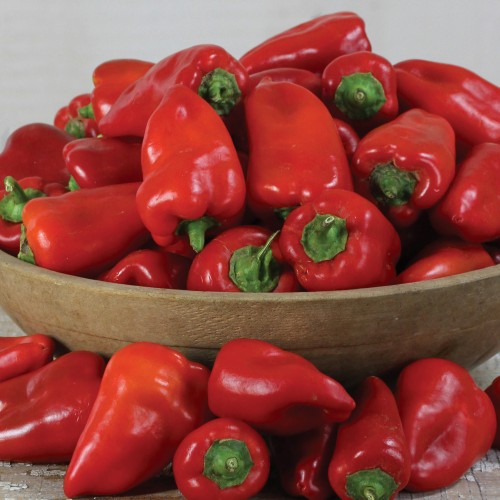The Lipstick pepper is a sweet, thick-walled heirloom pepper which matures earlier than bell peppers, making it an excellent alternative for those in northern climates. It also tends to be more prolific, putting out more peppers per plant.
Unknown on grocery store shelves, the Lipstick pepper is quickly becoming a favorite among home gardeners and heirloom commercial growers due to its ease of cultivation, high productivity, and clean, sweet flavor.
On this page:
Profile: Lipstick Pepper
A more prolific, earlier-ripening, heart-shaped alternative to bell peppers
Species: Capsicum annuum
Days to Maturity: 70 days
Type: Open Pollinated (OP)
Height: 24+ inches
Heat Level: 0 to 100 SHU (no perceptible heat)
Get seeds: Baker Creek (US), Refining Fire Chiles (US), HR Seeds (US), Incredible Seeds (Canada), Real Seeds (UK)
Lipstick peppers are crimson red, conical peppers with wide shoulders and a somewhat rounded bottom, giving them a heart shape. The peppers get to around 2 to 4 inches long. They are completely sweet, without even a tingle of heat, just like a bell pepper. However, some consider their flavor to be superior to bell peppers – Lipstick peppers taste very clean and sweet with no bitter notes.
Lipstick peppers can be harvested as green peppers sooner than the 70-day harvest date, and can be used in place of green bell peppers. However, they only become sweet after ripening.
Lipstick pepper plants can reach over 2 feet tall if given enough space, and if fertilized well, can produce heavier yields than bell peppers.
You can use Lipstick peppers in any dish you use other sweet bell peppers, such as stirfries, salads, salsas, or stuffed. You can even dry them and grind them into a kind of sweet paprika powder. However, because of the thick, juicy flesh, you should slice them thinly before drying.
Planting Lipstick Peppers
While Lipstick peppers produce earlier than bell peppers, they still benefit from starting indoors, 6 to 10 weeks before your last frost date. Sow your seeds in loose soil or potting mix and keep warm and moist until they sprout. Keep under fluorescent lights or LED grow lights to keep your pepper seedlings from getting leggy, but keep them no closer than 4 to 8 inches above your seedlings or you could overheat them.
When nighttime temperatures stay above 50°F (10°C), you can transplant your Lipstick peppers outdoors.
Before transplanting, you can add some slow-release fertilizer into the planting hole and mix in well to give your pepper transplants a head start. After transplanting, water liberally to reduce transplant shock and get the soil settled around the roots.
At this stage, they don’t need much fertilizer, and you can use any balanced granular fertilizer every month or apply diluted liquid feeds every 1 to 2 weeks. Once your plants are established, you can use fertilizer spikes like Jobe’s tomato spikes.
An alternative to applying fertilizer is planting your Lipstick peppers in compost or compost-rich soil, which should provide enough nutrients for the whole season.
Plant your Lipstick peppers in a place that gets direct sunlight for at least 6 hours a day to ensure proper growth, more blooms, and bigger harvests.
Taking Care of Lipstick Peppers
As long as you keep the soil around your Lipstick peppers moist but not soggy, and you have either planted in rich soil or amended with fertilizer or compost, you will end up with a good harvest. Peppers are self-pollinators, and just the wind gently shaking the plants will be enough to pollinate your flowers.
Peppers are also mostly resilient against pests, although you may occasionally find aphid infestations. Aphids are easily dealt with, and often don’t even require insecticidal soap. More rarely, pepper plants can be infested with tomato hornworms, which prefer tomatoes but occasionally attack other nightshades like peppers and tomatillos. Hornworms can be picked off and dispatched manually but if you have a large pepper garden, you can use organic pyrethrin or neem oil sprays.
Harvesting Lipstick Peppers
For peak sweetness and flavor, pick Lipstick peppers when they are fully ripe and completely turn red. You can also pick them green after they’ve reached their full size. Days to maturity for unripe Lipstick peppers is around 65 days.
Lipstick peppers will keep in the refrigerator for a couple weeks, but lose a lot of their freshness after a week. To store your Lipstick peppers long-term, consider chopping and freezing them, pickling them, or drying them.
Related Questions About Growing Lipstick Peppers
Can Lipstick Peppers Be Grown in a Pot?
Lipstick peppers, like all peppers, can grow well in pots. However, if you want a good harvest, plant your Lipstick peppers in at least a 5-gallon container. Planting in a small pot can cause your plant to be stunted and produce only a few peppers.
When planting in a pot, use well-draining potting mix and ensure your pot has drainage holes on the bottom.
Since peppers in pots often need more frequent watering, this can cause nutrients in your pots to deplete much faster than in the ground. Definitely fertilize your Lipstick peppers in pots regularly, either using slow-release fertilizer granules/spikes applied every 1-3 months or a liquid fertilizer applied every 1-2 weeks.

